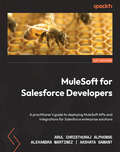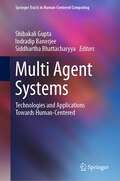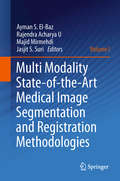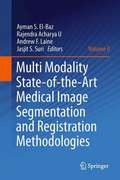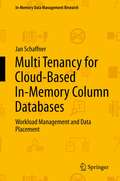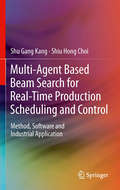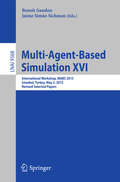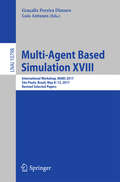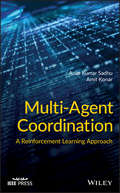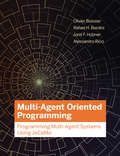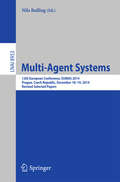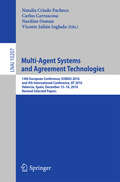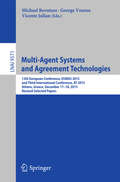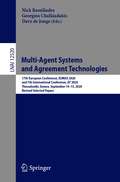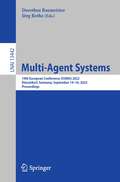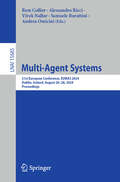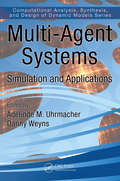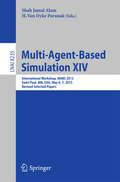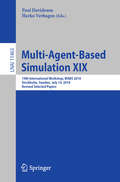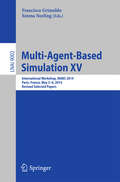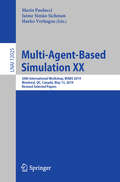- Table View
- List View
MuleSoft for Salesforce Developers: A practitioner's guide to deploying MuleSoft APIs and integrations for Salesforce enterprise solutions
by Arul Christhuraj Alphonse Alexandra Martinez Akshata SawantDesign, secure, test, and deploy APIs with MuleSoft, and integrate it with Salesforce to maximize productivityKey FeaturesBuild, implement, transform, secure, test, and deploy APIs using Anypoint Studio and Anypoint PlatformIntegrate MuleSoft with Salesforce and other end systems to build an application networkEnhance your Salesforce and MuleSoft skills and employability with interview and certification tips and tricksBook DescriptionMuleSoft for Salesforce Developers will help you build state-of-the-art enterprise solutions with flexible and scalable integration capabilities using MuleSoft's Anypoint Platform and Anypoint Studio. If you're a Salesforce developer looking to get started with this useful tool, look no further. This book will get you up to speed in no time, leveling up your integration developer skills. This essential guide will first introduce you to the fundamentals of MuleSoft and API-led connectivity, before walking you through the API life cycle and the Anypoint Studio IDE. Once you have the IDE set up, you'll be ready to create Mule applications. You'll look at the core components of MuleSoft and Anypoint Platform, and before long you'll know how to build, transform, secure, test, and deploy applications using the wide range of components available to you. Finally, you'll learn about using connectors to integrate MuleSoft with Salesforce and to fulfill a number of use cases, which will be covered in depth, along with interview and certification tips. By the end of this book, you will be confident building MuleSoft integrations at an enterprise scale and be able to gain the fundamental MuleSoft certification – MCD.What you will learnUnderstand how to use MuleSoft to achieve API-led connectivityDesign and create documentation for your APIDevelop Mule applications and run them in Anypoint StudioMonitor your applications from Anypoint PlatformTransform your data using DataWeaveUse the CI/CD and Mule Maven pluginsRun tests using MUnit and generate a code coverage reportUse best practices to maintain coding standardsWho this book is forThis book is for Salesforce developers who want to get started with MuleSoft. Salesforce architects will also find the concepts covered in the book useful in designing Salesforce solutions. Prior knowledge of any programming language and some basic integration concepts will be helpful, alongside basic familiarity with Salesforce development and experience with at least one Salesforce API – including the SOAP API, REST API, Bulk API, or Streaming API.
Multi Agent Systems: Technologies and Applications towards Human-Centered (Springer Tracts in Human-Centered Computing)
by Siddhartha Bhattacharyya Shibakali Gupta Indradip BanerjeeThe book presents latest multi-agent technologies in human-centered computing (HCC) to provide a new research direction to enrich the human socio computations. Nowadays, the research in the field of multi-agent system (MAS) has gained a wide spread recognition due to its interdisciplinary nature and a vast versatile application domain including engineering, social science, economics, mathematics, operational research, etc. It has been proved that agents in MAS are the most appropriate technological paradigm for providing the most optimal solution for different kinds of complex real world problems that may be industrial or it might be specifically related to social problems. Keeping these features in mind, we planned to tune the research of latest multi-agent technologies and tried to compose its effect on HCC corridor. The primary audience of this book are research students of computer science, information technology and it will be also very helpful for software professionals to get developmental ideas to boost their computing activities.
Multi Modality State-of-the-Art Medical Image Segmentation and Registration Methodologies. Volume 1
by Jasjit S. Suri Majid Mirmehdi Ayman S. El-Baz Rajendra Acharya UWith the advances in image guided surgery for cancer treatment, the role of image segmentation and registration has become very critical. The central engine of any image guided surgery product is its ability to quantify the organ or segment the organ whether it is a magnetic resonance imaging (MRI) and computed tomography (CT), X-ray, PET, SPECT, Ultrasound, and Molecular imaging modality. Sophisticated segmentation algorithms can help the physicians delineate better the anatomical structures present in the input images, enhance the accuracy of medical diagnosis and facilitate the best treatment planning system designs. The focus of this book in towards the state of the art techniques in the area of image segmentation and registration.
Multi Modality State-of-the-Art Medical Image Segmentation and Registration Methodologies: Volume II
by Jasjit S. Suri Ayman S. El-Baz Rajendra Acharya U Andrew F. LaineWith the advances in image guided surgery for cancer treatment, the role of image segmentation and registration has become very critical. The central engine of any image guided surgery product is its ability to quantify the organ or segment the organ whether it is a magnetic resonance imaging (MRI) and computed tomography (CT), X-ray, PET, SPECT, Ultrasound, and Molecular imaging modality. Sophisticated segmentation algorithms can help the physicians delineate better the anatomical structures present in the input images, enhance the accuracy of medical diagnosis and facilitate the best treatment planning system designs. The focus of this book in towards the state of the art techniques in the area of image segmentation and registration.
Multi Tenancy for Cloud-Based In-Memory Column Databases: Workload Management and Data Placement
by Jan SchaffnerWith the proliferation of Software-as-a-Service (SaaS) offerings, it is becoming increasingly important for individual SaaS providers to operate their services at a low cost. This book investigates SaaS from the perspective of the provider and shows how operational costs can be reduced by using "multi tenancy," a technique for consolidating a large number of customers onto a small number of servers. Specifically, the book addresses multi tenancy on the database level, focusing on in-memory column databases, which are the backbone of many important new enterprise applications. For efficiently implementing multi tenancy in a farm of databases, two fundamental challenges must be addressed, (i) workload modeling and (ii) data placement. The first involves estimating the (shared) resource consumption for multi tenancy on a single in-memory database server. The second consists in assigning tenants to servers in a way that minimizes the number of required servers (and thus costs) based on the assumed workload model. This step also entails replicating tenants for performance and high availability. This book presents novel solutions to both problems.
Multi-Access Edge Computing in Action
by Dario Sabella Alex Reznik Rui FrazaoThis book provides a complete and strategic overview of Multi-Access Edge Computing (MEC). It covers network and technology aspects, describes the market scenarios from the different stakeholders’ point of view, and analyzes deployment aspects and actions to engage the ecosystem. MEC exists in and supports a highly complex "5G world" in which technologists and non-technology decision makers must act in concert and do so within a large interconnected ecosystem of which MEC is just one, albeit an important, part. Divided into three sections, with several chapters in each, the book addresses these three key aspects: technology, markets, and ecosystems.
Multi-Agent Based Beam Search for Real-Time Production Scheduling and Control
by Shiu Hong Choi Shu Gang KangThe Multi-Agent Based Beam Search (MABBS) method systematically integrates four major requirements of manufacturing production - representation capability, solution quality, computation efficiency, and implementation difficulty - within a unified framework to deal with the many challenges of complex real-world production planning and scheduling problems. Multi-agent Based Beam Search for Real-time Production Scheduling and Control introduces this method, together with its software implementation and industrial applications. This book connects academic research with industrial practice, and develops a practical solution to production planning and scheduling problems. To simplify implementation, a reusable software platform is developed to build the MABBS method into a generic computation engine. This engine is integrated with a script language, called the Embedded Extensible Application Script Language (EXASL), to provide a flexible and straightforward approach to representing complex real-world problems. Adopting an in-depth yet engaging and clear approach, and avoiding confusing or complicated mathematics and formulas, this book presents simple heuristics and a user-friendly software platform for system modelling. The supporting industrial case studies provide key information for students, lecturers, and industry practitioners alike. Multi-agent Based Beam Search for Real-time Production Scheduling and Control offers insights into the complex nature of and a practical total solution to production planning and scheduling, and inspires further research and practice in this promising research area.
Multi-Agent Based Simulation XVI
by Benoit Gaudou Jaime Simão SichmanThis bookconstitutes the thoroughly refereed post-conference proceedings of the 16thInternational Workshop on Multi-Agent-Based Simulation, MABS 2015, held inIstanbul, Turkey, in May 2015. The workshop was held in conjunction with the14th International Conference on Autonomous Agents and Multi-agent Systems,AAMAS 2015. The 12revised full papers included in this volume ware carefully selected from 22submissions. The papers focus on theinfluence of social sciences and multi-agent systems, with a strongapplication/empirical vein, and its emphasis is stressed on exploratory agentbased simulation as a principled way of undertaking scientific research in thesocial sciences and using social theories as an inspiration to new frameworks and developments in multi-agent systems.
Multi-Agent Based Simulation XVIII: International Workshop, Mabs 2017, São, Brazil, May 8-12. 2017, Revised Selected Papers (Lecture Notes in Computer Science #10798)
by Luis Antunes Graçaliz Pereira DimuroThis book constitutes the thoroughly refereed post-conference proceedings of the 18th International Workshop on Multi-Agent-Based Simulation, MABS 2017, held in Sao Paulo, Brazil, in May 2017. The workshop was held in conjunction with the 16th International Conference on Autonomous Agents and Multi-Agent Systems, AAMAS 2017. The 15 revised full papers included in this volume were carefully selected from 23 submissions. The topic of the papers is about applying agent-based simulation techniques to real-world problems focusing on the confluence of socio-technical-natural sciences and multi-agent systems with a strong application/empirical vein.
Multi-Agent Coordination: A Reinforcement Learning Approach (Wiley - IEEE)
by Amit Konar Arup Kumar SadhuDiscover the latest developments in multi-robot coordination techniques with this insightful and original resource Multi-Agent Coordination: A Reinforcement Learning Approach delivers a comprehensive, insightful, and unique treatment of the development of multi-robot coordination algorithms with minimal computational burden and reduced storage requirements when compared to traditional algorithms. The accomplished academics, engineers, and authors provide readers with both a high-level introduction to, and overview of, multi-robot coordination, and in-depth analyses of learning-based planning algorithms. You'll learn about how to accelerate the exploration of the team-goal and alternative approaches to speeding up the convergence of TMAQL by identifying the preferred joint action for the team. The authors also propose novel approaches to consensus Q-learning that address the equilibrium selection problem and a new way of evaluating the threshold value for uniting empires without imposing any significant computation overhead. Finally, the book concludes with an examination of the likely direction of future research in this rapidly developing field. Readers will discover cutting-edge techniques for multi-agent coordination, including: An introduction to multi-agent coordination by reinforcement learning and evolutionary algorithms, including topics like the Nash equilibrium and correlated equilibrium Improving convergence speed of multi-agent Q-learning for cooperative task planning Consensus Q-learning for multi-agent cooperative planning The efficient computing of correlated equilibrium for cooperative q-learning based multi-agent planning A modified imperialist competitive algorithm for multi-agent stick-carrying applications Perfect for academics, engineers, and professionals who regularly work with multi-agent learning algorithms, Multi-Agent Coordination: A Reinforcement Learning Approach also belongs on the bookshelves of anyone with an advanced interest in machine learning and artificial intelligence as it applies to the field of cooperative or competitive robotics.
Multi-Agent Oriented Programming: Programming Multi-Agent Systems Using JaCaMo (Intelligent Robotics and Autonomous Agents series)
by Olivier Boissier Alessandro Ricci Rafael H. Bordini Jomi HubnerThe main concepts and techniques of multi-agent oriented programming, which supports the multi-agent systems paradigm at the programming level.A multi-agent system is an organized ensemble of autonomous, intelligent, goal-oriented entities called agents, communicating with each other and interacting within an environment. This book introduces the main concepts and techniques of multi-agent oriented programming, (MAOP) which supports the multi-agent systems paradigm at the programming level. MAOP provides a structured approach based on three integrated dimensions, which the book examines in detail: the agent dimension, used to design the individual (interacting) entities; the environment dimension, which allows the development of shared resources and connections to the real world; and the organization dimension, which structures the interactions among the autonomous agents and the shared environment.
Multi-Agent Systems
by Nils BullingThis book constitutes the proceedings of the 12th European Conference on Multi-Agent Systems, EUMAS 2014, held in Prague, Czech Republic, in December 2014. The 21 full papers and 8 short papers presented in this volume were carefully reviewed and selected from 79 submissions. They are organized in topical sections named: agent-based models, trust and reputation; coordination, coalitions and teamwork; logic and formal approaches; theories in practice and real-world problems; decision making, conflicts and agreements.
Multi-Agent Systems and Agreement Technologies
by Nardine Osman Natalia Criado Pacheco Carlos Carrascosa Vicente Julián IngladaThis book constitutes the revised selected papers from the 14th European Conference on Multi-Agent Systems, EUMAS 2016, and the Fourth International Conference on Agreement Technologies, AT 2016, held in Valencia, Spain, in December 2016. The 43 papers and 2 invited papers presented in this volume were carefully reviewed and selected from 68 submissions. The papers cover thematic areas as agent and multi-agent system models, algorithms, applications, simulations, theoretical studies, and for AT the thematic areas are: algorithms
Multi-Agent Systems and Agreement Technologies
by Michael Rovatsos George Vouros Vicente JulianThis book constitutes the revised selected papers from the 13 European Conference on Multi-Agent Systems, EUMAS 2015, and the Third International Conference on Agreement Technologies, AT 2015, held in Athens, Greece, in December 2015. The 36 papers presented in this volume were carefully reviewed and selected from 65 submissions. They are organized in topical sections named: coordination and planning; learning and optimization, argumentation and negotiation; norms, trust, and reputation; agent-based simulation and agent programming.
Multi-Agent Systems and Agreement Technologies: 17th European Conference, EUMAS 2020, and 7th International Conference, AT 2020, Thessaloniki, Greece, September 14-15, 2020, Revised Selected Papers (Lecture Notes in Computer Science #12520)
by Nick Bassiliades Georgios Chalkiadakis Dave De JongeThis book constitutes the revised post-conference proceedings of the 17th European Conference on Multi-Agent Systems, EUMAS 2020, and the 7th International Conference on Agreement Technologies, AT 2020, which were originally planned to be held as a joint event in Thessaloniki, Greece, in April 2020. Due to COVID-19 pandemic the conference was postponed to September 2020 and finally became a fully virtual conference. The 38 full papers presented in this volume were carefully reviewed and selected from a total of 53 submissions. The papers report on both early and mature research and cover a wide range of topics in the field of autonomous agents and multi-agent systems.
Multi-Agent Systems: 16th European Conference, EUMAS 2018, Bergen, Norway, December 6–7, 2018, Revised Selected Papers (Lecture Notes in Computer Science #11450)
by Marija SlavkovikThis book constitutes the revised post-conference proceedings of the 16th European Conference on Multi-Agent Systems, EUMAS 2018, held at Bergen, Norway, in December 2018.The 18 full papers presented in this volume were carefully reviewed and selected from a total of 34 submissions. The papers report on both early and mature research and cover a wide range of topics in the field of multi-agent systems.
Multi-Agent Systems: 18th European Conference, EUMAS 2021, Virtual Event, June 28–29, 2021, Revised Selected Papers (Lecture Notes in Computer Science #12802)
by Ariel Rosenfeld Nimrod TalmonThis book constitutes the revised post-conference proceedings of the 18th European Conference on Multi-Agent Systems, EUMAS 2021. The conference was held online in June, 2021. 16 full papers are presented in this volume, each of which carefully reviewed and selected from a total of 51 submissions. The papers report on both early and mature research and cover a wide range of topics in the field of multi-agent systems.
Multi-Agent Systems: 19th European Conference, EUMAS 2022, Düsseldorf, Germany, September 14–16, 2022, Proceedings (Lecture Notes in Computer Science #13442)
by Jörg Rothe Dorothea BaumeisterThis book constitutes thoroughly refereed and revised selected papers from the proceedings of 19th European Conference on Multi-Agent Systems, EUMAS 2022, held in Düsseldorf, Germany, during September 14–16, 2022.The 23 full papers included in this book were carefully reviewed and selected from 36 submissions. The book also contains 6 short summaries of talks from PhD students at the PhD day. The papers deal with current topics in the research and development of multi-agent systems.
Multi-Agent Systems: 20th European Conference, EUMAS 2023, Naples, Italy, September 14–15, 2023, Proceedings (Lecture Notes in Computer Science #14282)
by Vadim Malvone Aniello MuranoThis volume LNCS 14282 constitutes the refereed proceedings of the 20th European Conference EUMAS 2023, held in Naples, Italy, during September 2023.This volume includes 24 full papers and 5 short papers, carefully selected from 47 submissions. Additionally, the volume features 16 short papers, rigorously reviewed from 20 submissions for the PhD day. The conference focused on the theory and practice of autonomous agents and multi-agent systems, covering a wide range of topics.
Multi-Agent Systems: 21st European Conference, EUMAS 2024, Dublin, Ireland, August 26–28, 2024, Proceedings (Lecture Notes in Computer Science #15685)
by Alessandro Ricci Andrea Omicini Rem Collier Vivek Nallur Samuele BurattiniThis book constitutes the refereed proceedings of the 21st European Conference on Multi-Agent Systems, EUMAS 2024, which took place in Dublin, Ireland, on August 26, 2024. The 24 full papers and 1 short paper included in this book were carefully reviewed and selected from 36 submissions. They were organized in topical sections as follows: Multi-Agent Based Simulation; Multi-Agent Learning; Knowledge Representation, Reasoning and Planning; Human-Agent Interaction; Coordination, Organisations, Institutions, Norms andEthics; and Engineering Multi-Agent Systems.
Multi-Agent Systems: Simulation and Applications (Computational Analysis, Synthesis, and Design of Dynamic Systems #Vol. 1)
by Adelinde M. Uhrmacher and Danny WeynsMethodological Guidelines for Modeling and Developing MAS-Based SimulationsThe intersection of agents, modeling, simulation, and application domains has been the subject of active research for over two decades. Although agents and simulation have been used effectively in a variety of application domains, much of the supporting research remains scattered in the literature, too often leaving scientists to develop multi-agent system (MAS) models and simulations from scratch. Multi-Agent Systems: Simulation and Applications provides an overdue review of the wide ranging facets of MAS simulation, including methodological and application-oriented guidelines. This comprehensive resource reviews two decades of research in the intersection of MAS, simulation, and different application domains. It provides scientists and developers with disciplined engineering approaches to modeling and developing MAS-based simulations. After providing an overview of the field’s history and its basic principles, as well as cataloging the various simulation engines for MAS, the book devotes three sections to current and emerging approaches and applications.Simulation for MAS — explains simulation support for agent decision making, the use of simulation for the design of self-organizing systems, the role of software architecture in simulating MAS, and the use of simulation for studying learning and stigmergic interaction.MAS for Simulation — discusses an agent-based framework for symbiotic simulation, the use of country databases and expert systems for agent-based modeling of social systems, crowd-behavior modeling, agent-based modeling and simulation of adult stem cells, and agents for traffic simulation. Tools — presents a number of representative platforms and tools for MAS and simulation, including Jason, James II, SeSAm, and RoboCup Rescue.Complete with over 200 figures and formulas, this reference book provides the necessary overview of experiences with MAS simulation and the tools needed to exploit simulation in MAS for future research in a vast array of applications including home security, computational systems biology, and traffic management.
Multi-Agent-Based Simulation XIV
by Shah Jamal Alam H. Van Dyke ParunakThis book constitutes the thoroughly refereed post-conference proceedings of the 14th International Workshop on Multi-Agent-Based Simulation, MABS 2013, held in Saint Paul, Minnesota, USA, in May 2013. The workshop was help in conjunction with Twelfth International Conference on Autonomous Agents and Multiagent Systems, AAMAS 2013. The 11 revised full papers included in this volume were carefully selected from 29 submissions. The papers are organized in topical sections on MABS for real-time and online data, formal approaches in MABS: design and validation, MABS in environmental modeling, simulating social phenomena.
Multi-Agent-Based Simulation XIX: 19th International Workshop, MABS 2018, Stockholm, Sweden, July 14, 2018, Revised Selected Papers (Lecture Notes in Computer Science #11463)
by Paul Davidsson Harko VerhagenThis book constitutes the thoroughly refereed post-conference proceedings of the 19th International Workshop on Multi-Agent-Based Simulation, MABS 2019, held in Stockholm Sweden, in July 2018 as part of the Federated AI Meeting, FAIM 2018. The 10 revised full papers included in this volume were carefully selected from 15 submissions. They focus on finding efficient solutions to model complex social systems in such areas as economics, management, and organisational and social sciences. In all these areas, agent theories, metaphors, models, analysis, experimental designs, empirical studies, and methodological principles, converge into simulation as a way of achieving explanations and predictions, exploration and testing of hypotheses, better designs and systems.
Multi-Agent-Based Simulation XV
by Francisco Grimaldo Emma NorlingThis book constitutes the thoroughly refereed post-conference proceedings of the 15th International Workshop on Multi-Agent-Based Simulation, MABS 2014, held in Paris, France, in May 2014. The workshop was held in conjunction with the 13th International Conference on Autonomous Agents and Multiagent Systems, AAMAS 2014. The 17 revised full papers included in this volume were carefully selected from numerous submissions. The papers are organized in topical sections on simulation methodologies, simulation of social behaviour, data and multi-agent-based simulation and applications.
Multi-Agent-Based Simulation XX: 20th International Workshop, MABS 2019, Montreal, QC, Canada, May 13, 2019, Revised Selected Papers (Lecture Notes in Computer Science #12025)
by Jaime Simão Sichman Harko Verhagen Mario PaolucciThis book constitutes the thoroughly refereed post-conference proceedings of the 20th International Workshop on Multi-Agent-Based Simulation, MABS 2019, held in Montreal, QC, Canada, in May 2019 as part of the AAMAS 2019, the 18th International Conference on Autonomous Agents and Multiagent Systems.The 9 revised full papers included in this volume were carefully selected from 15 submissions. They focus on finding efficient solutions to model complex social systems in such areas as economics, management, and organisational and social sciences. In all these areas, agent theories, metaphors, models, analysis, experimental designs, empirical studies, and methodological principles, converge into simulation as a way of achieving explanations and predictions, exploration and testing of hypotheses, better designs and systems.
